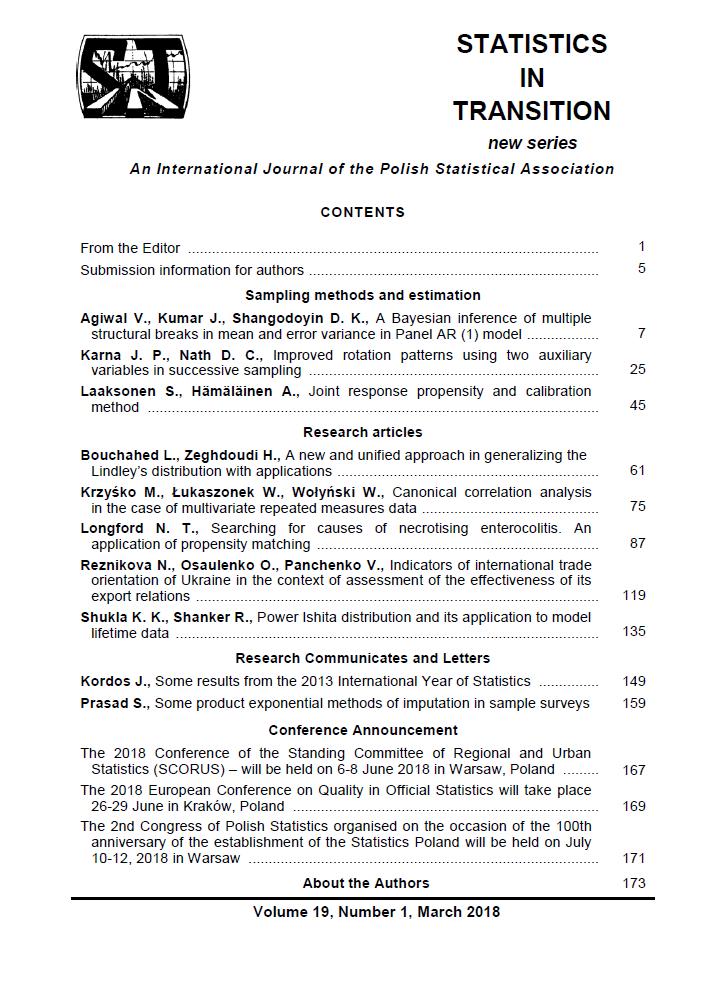ARTICLE
ABSTRACT
This paper examines the chain of weights, beginning with the basic sampling weights for the respondents. These were then converted to reweights to reduce the bias due to missing quantities. If micro auxiliary variables are available for a gross sample, we suggest taking advantage first of the response propensity weights, and then of the calibrated weights with macro (aggregate) auxiliary variables. We also examined the calibration methodology that starts from the basic weights. Simulated data based on a real survey were used for comparison. The sampling design used was stratified simple random sampling, but the same methodology works for multi-stage sampling as well. Eight indicators were examined and estimated. We found differences in the performance of the reweighting methods. However, the main conclusion was that the response propensity weights are the best starting weights for calibration, since the auxiliary variables can be more completely exploited in this case. We also tested problems of calibration methods, since some weights may lead to unacceptable weights, such as below 1 or even negative.
KEYWORDS
reweighting, simulation study, macro vs. micro auxiliary variables, case of negative and other implausible weights
REFERENCES
BRICK, J. M., (2013). Unit Nonresponse and Weighting Adjustments: A Critical Review, Journal of Official Statistics, 29, 3, pp. 329–353.
BRICK, J. M., JONES, M. E., (2008). Propensity to respond and Nonresponse Bias, METRON – International Journal of Statistics, LXVI, 1, pp. 51–73.
DEVILLE, J-C., SÄRNDAL, C-E., (1992). Calibration Estimators in Survey Sampling, Journal of the American Statistical Association, pp. 376–382.
DEVILLE, J-C., SÄRNDAL, C-E., SAUTORY, O., (1993). Generalized Raking Procedures in Survey Sampling, Journal of the American Statistical Association, pp. 1013–1020.
EKHOLM, A., LAAKSONEN, S., (1991). Weighting via Response Modelling in the Finnish Household Budget Survey, Journal of Official Statistics. 7.2, pp. 325–337.
ESS _ European Social Survey, (2014). Documentation of ESS Post-Stratification Weights.
http://www.europeansocialsurvey.org/docs/methodology/ESS_post_stratification_weights_documentation.pdf.
ESTEVAO, V. M., SÄRNDAL, C-E., (2006). Survey Estimates by Calibration on Complex Auxiliary Information, International Statistical Review 74, 2, pp. 127–147.
HAZIZA, D., LESAGE, E. (2016). A Discussion of Weighting Procedures for Unit Nonresponse, Journal of Official Statistics 32, 1, pp. 129–145, http://dx.doi.org/10.1515/JOS-2016-0006.
HENRY, K. A., VALLIANT, R., (2015). A design effect measure for calibration weighting in single stage samples, Survey Methodology 41, 2, pp. 315–331.
HOLT, D., SMITH, T. M. F., (1979). Post-Stratification. Journal of the Royal Statistical Society, Series A (General). Vol. 142, pp. 33–46.
KOTT, P., (2006). Using Calibration Weighting to Adjust for Nonresponse and Coverage Errors. Survey Methodology 32, 2, pp. 133–142.
KOTT, P. CHANG, T., (2008). Can calibration be used for ‘nonignorable’ nonresponse, Proceedings of Joint Statistical Meeting. Section of Survey Research, pp. 251–260.
KOTT, P., CHANG, T., (2010). Using Calibration Weighting to Adjust for Nonignorable Unit Nonresponse, Journal of the American Statistical Association, pp. 105–491.
LUMLEY, T., (2013). Survey: Analysis of Complex Survey Samples. R package version 3.29, URL http://CRAN.R-project.org/package=survey.
LUMLEY, T., SHAW, P., DAI, J. Y., (2011). Connections between Survey Calibration Estimators and Semiparametric Models for Incomplete Data. International Statistical Review 79, 2, pp. 200–220, DOI: 10.1111/j.1751-5823.2011.00138.x.
LAAKSONEN, S., (2007). Weighting for Two-Phase Surveyed Data. Survey Methodology, December Vol. 33, No. 2, pp. 121–130, Statistics Canada.
LAAKSONEN, S., (2015). Sampling Design Data File, Survey Statistician 72, pp 61–66.
LAAKSONEN, S., HEISKANEN, M., (2014). Comparison of Three modes for a Crime Victimization Survey, Journal of Survey Statistics and Methodology, 2 (4), pp. 459–483, DOI 10.1093/jssam/smu018.
LAAKSONEN, S., KEMPPAINEN, T., STJERNBERG, M., KORTTEINEN, M., VAATTOVAARA, M., LÖNNQVIST, H., (2015). Tackling City-Regional Dynamics in a Survey Using Grid Sampling. Survey. Research Methods by the European Survey Research Association, Vol 9, No 1, pp. 55–65,www.surveyresearch.org.
Le GUENNEC. J., SAUTORY. O., (2005). CALMAR 2: Une Nouvelle Version de la Macro Calmar de Redressment D’Échantillion Par Calage, http://vserver insee.nexen.net/jms2005/site/files/documents/2005/327_1-JMS2002_SESSION1_LE-GUENNEC-SAUTORY_CALMAR-2_ACTES.PDF.
LITTLE. R. J. A., (1986). Survey Nonresponse Adjustments for Estimates of Means, International Statistical Review, 54, pp. 139–157.
LITTLE, R. J. A., RUBIN, D. B., (2002). Statistical Analysis with Missing Data, 2nd Edition. Wiley.
LUNDQUIST, P., SÄRNDAL, C-E., (2013). Aspects of Responsive Design with Applications to the Swedish Living Conditions Survey. Journal of Official Statistics 29, 4, pp. 557–582, DOI: org/10.2478/jos-2013-0040.
LUNDSTRÖM, S., SÄRNDAL, C-E., (1999). Calibration as a Standard Method for Treatment of Nonresponse, Journal of Official Statistics, 15, 2, pp. 305–327.
McCORMACK, K., (2006). The calibration software CALMAR – What is it? Central Statistics Office Ireland, http://vesselinov.com/CalmarEngDoc.pdf.
ROBINS, J. M., ROTNITZKY, A., ZHAO, L.-P., (1994). Estimation of regression coefficients when some regressors are not always observed, Journal of the American Statistical Association 89, pp. 846–866.
PLIKUSAS, A., PUMPUTIS, D., (2010). Estimation of the finite population covariance using calibration. Nonlinear Analysis: Modelling and Control, Vol. 15, 3, pp. 325–340.
SAUTORY, O., (2003). CALMAR 2: A New Version of the Calmar Calibration Adjustment Program, Proceedings of Statistics Canada’s Symposium: Challenges in Survey Taking for the Next Decade.
SÄRNDAL, C-E., (2007). Calibration Approach in Survey Theory and Practice,Survey Methodology, 33, No. 2, pp. 99–119.
SMITH, T. M. F., (1991). Post-stratification, The Statistician 40, pp. 315–323.
VALLIANT, R., DEVER, J. A., KREUTER, F., (2013). Practical Tools for Designing and Weighting Survey Samples, Statistics for Social and Behavioral Sciences. Springer.
WITTENBERG, M., (2009). Sample Survey Calibration: An Information-theoretic perspective, A Southern Africa Labour and Development Research Unit Working Paper Number 41, Cape Town: SALDRU, University of Cape Town
